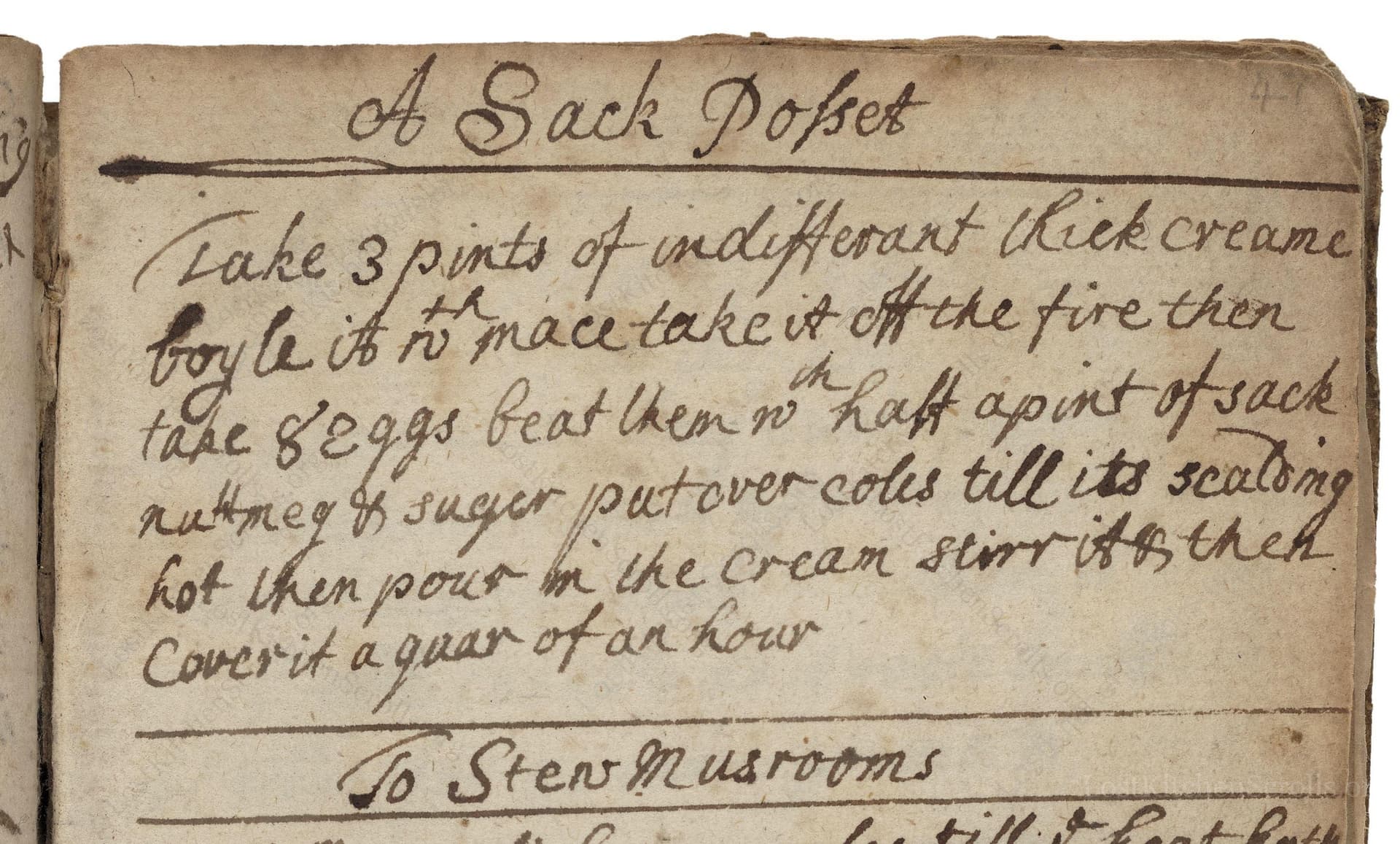A Sack Posset
From the treasured pages of Medicinal and cookery recipes of Mary Baumfylde
Written by Mary Baumfylde

A Sack Posset
"Take 3 pints of indifferent thick creame boyle it to make take it off the fire then take 8 Eggs beat them in half apint of sack nutmeg & sugyr put over coles till its scalding hot then pour in the cream stirr it, & then Cover it a quar of an hour"
Note on the Original Text
The original recipe is written in a style typical of seventeenth-century English household manuscripts: brief, assuming prior knowledge, and freely spelling words like 'boyle' (boil), 'sugyr' (sugar), and 'colles' (coals). Instructions are often implicit—the reader is expected to know how to 'stirr it' or recognize when something is 'scalding hot.' There are no precise temperatures, no stepwise timings beyond a 'quart of an hour,' and quantities are based on pints and quarts. This charming vagueness meant that every cook made the recipe their own, adding a pinch of this or whisk of that as they saw fit!

Title
Medicinal and cookery recipes of Mary Baumfylde (1626)
You can also click the book image above to peruse the original tome
Writer
Mary Baumfylde
Era
1626
Publisher
Unknown
Background
A sumptuous journey into early 17th-century English cookery, this delightful volume offers a tantalizing glimpse into the recipes, flavors, and culinary secrets that once graced aristocratic tables. Prepare for a taste of history, presented with wit and wisdom!
Kindly made available by
Folger Shakespeare Library
This Sack Posset hails from early modern England, a time when hot possets were both fashionable and restorative—beloved as a warming drink, a celebratory punch, or even a gentle tonic for the unwell. Mary Baumfylde, active in the mid-1600s, included this recipe in her personal collection, reflecting the then-popular use of sack (a type of fortified wine imported from Spain) and the richness that only the upper classes could afford. This luxurious blend of cream, eggs, spice, and wine was a culinary symbol of both hospitality and status. The recipe’s journey from its origin to the later eighteenth century (1702–1758) shows the enduring appeal of comforting, festive beverages in English households.

This posset would have been prepared over a hearth with glowing coals, using sturdy earthenware or copper pots for heating the cream and egg-wine mixture. Whisks or branches would have beaten the eggs. To serve, posset pots—distinctive lidded vessels with spouts for sipping the whey—were common in wealthier homes. Lacking such, any deep bowl or jug would have been pressed into service. Covering the pot to let the curds form was often done with a cloth or a dedicated wooden lid.
Prep Time
10 mins
Cook Time
15 mins
Servings
8
We've done our best to adapt this historical recipe for modern kitchens, but some details may still need refinement. We warmly welcome feedback from fellow cooks and culinary historians — your insights support the entire community!
Ingredients
- 7 cups heavy cream
- 8 large eggs
- 1 1/4 cups sweet sherry (or sack wine, if available)
- 1/2 teaspoon grated nutmeg
- 1/4 cup granulated sugar (or to taste)
Instructions
- To make a Sack Posset in a modern kitchen, start with 7 cups (about 1.7 quarts) of heavy cream and gently bring it to a simmer in a pot, careful not to let it boil over.
- In a separate bowl, beat 8 eggs thoroughly with 1 1/4 cups (about 10 fluid ounces) of sweet sherry (substituting for sack wine), adding grated nutmeg and sugar to taste—start with 1/2 teaspoon nutmeg and 1/4 cup (about 1.75 ounces) sugar.
- Warm this egg and sherry mixture gently over low heat, stirring constantly, until it is just hot to the touch but not scrambled.
- Remove both mixtures from heat.
- Pour the hot cream in a steady stream into the egg-sherry mix, stirring all the while.
- Cover the mixture and let it rest for 15 minutes, so the curds and whey separate.
- Serve warm, offering both thick, custardy curds and the delicate, boozy whey beneath.
Estimated Calories
440 per serving
Cooking Estimates
You’ll spend about 10 minutes prepping the ingredients, then about 15 minutes cooking and heating everything together. This recipe makes 8 servings, and each serving contains around 440 calories.
As noted above, we have made our best effort to translate and adapt this historical recipe for modern kitchens, taking into account ingredients nowadays, cooking techniques, measurements, and so on. However, historical recipes often contain assumptions that require interpretation.
We'd love for anyone to help improve these adaptations. Community contributions are highly welcome. If you have suggestions, corrections, or cooking tips based on your experience with this recipe, please share them below.
Join the Discussion
Rate This Recipe
Dietary Preference
Main Ingredients

Den Bockfisch In Einer Fleisch Suppen Zu Kochen
This recipe hails from a German manuscript cookbook compiled in 1696, a time whe...

Die Grieß Nudlen Zumachen
This recipe comes from a rather mysterious manuscript cookbook, penned anonymous...

Ein Boudain
This recipe comes from an anonymous German-language manuscript cookbook from 169...

Ein Gesaltzen Citroni
This recipe, dating from 1696, comes from an extensive anonymous German cookbook...
Browse our complete collection of time-honored recipes



